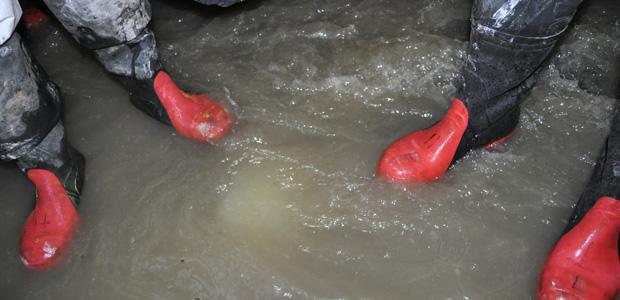London’s water service looking to turn sewer’s ‘fatbergs’ into power
The agency that runs the London sewers is planning to turn some sewage fat into electricity. (Photo by Cordelia Hebblethwaite.)
BY Cordelia Hebblethwaite
“How far is it?” I ask, my hands tightly gripping onto a slimy, slippery ladder, my heart suddenly surging with a fluttery, paralyzing panic.
I’m suited and booted in a white plastic overcoat, waders up to my thighs, and a crooked too-big hardhat.
And I’m halfway down a sheer-drop man-hole en route to a sewer to look at a great big pile of fat, wondering whether to turn round.
Put it this way: this is not a glamorous assignment.
With some trepidation, I step slowly down to the bottom, to find a rush of gushing water.
We’re not far from Trafalgar Square, one of London’s key landmarks. But down here it’s a different world. Mold hangs from the walls all around. And that’s just the start.
“You really start to smell it from about here,” said Gary Bell, part of the sewer team with Thames Water, which runs the sewers in London.
I’m here to see — and sniff — what those in the business call a “fatberg.”
Fatbergs are giant accumulations of fat from cooking oil that people pour down drains.
Every year there are about 40,000 fatberg blockages in the capital and surrounding area. It’s a major problem — costing Thames Water more than $1.5m every month to clean them out.
There’s a particularly stubborn fatberg lurking just round the corner.
Rob Smith, the “chief flusher” for Thames Water, takes me for a closer look.
Holding on tight to the side rail, we step on down. The water cascades down, almost like a waterfall, before stopping promptly at the blockage. But it is far from an idyllic scene.
We’re standing a few feet from what I, as a novice to this, can only describe as looking a bit like a cross between vomit and feces.
“That’s a pretty fair description, yeah. It’s not pure lard — you wouldn’t fry your breakfast in it, would ya?” Smith said.
Definitely not.
Hanging on the side rail, a load of wet wipes have strung themselves into chains, and hang listlessly.
I spot a tampon nestled within the fatberg.
Because fat is sticky, “anything and everything” ends up getting stuck inside, Smith said.
“I daresay there’s Johnny’s little goldfish in there somewhere or other as well — we do get those down here,” he said.
What we can see through the darkness with our headlamps is just the tip of this particular fatberg. It stretches 75 or 100 feet into the sewer before turning completely solid.
And just like an iceberg, it sits much deeper beneath the water level than above.
It’s causing a blockage in the system, and Smith is going to have to jet-blast it out.
“They don’t get much worse than that. I mean fatbergs are fatbergs. They are utterly vile,” said Simon Evans, a spokesman with Thames Water.
He’s the man who came up with the term “fatberg,” but that is not what he wants to talk about today.
He’s excited about plans to open what is being billed as the biggest fat-fueled power station in the world, in Beckton in the east of London.
It’s due to start pumping out electricity in two years’ time. Thames Water will supply about half the fuel.
Most of it will be collected from the capital’s restaurants — in “fat traps” fitted directly beneath sinks — but the rest will come from sewers like this.
“Nothing like this has been done in the world before, this is a world first — nothing like this on this scale has ever been done,” Evans said.
Fat has been converted into bio-diesel for cars before. That’s not new. Nor is the technology itself. But the idea of fueling a power plant of this scale is, according to the company behind the scheme, 2OC.
At the moment, fatbergs cleared from sewers are dumped on landfill sites, so this could be a win-win situation.
The fat-fueled power station will provide enough energy to power almost 40,000 homes, though about half of this has already been ear-marked to run a sewage plant next door.
If it works, says Evans, the project could act as a model for other cities in Britain, and beyond.
“If it does come off, there’s no reason why all these big cities around the world — New York, Los Angeles, you name it — shouldn’t have these kind of programmes going on in their neighbourhoods as well,” he said.
It’s yet to be tested, but those involved insist there’ll be no smoke, no smell and no greasy implications for people living nearby.
Chief flusher Rob Smith has been in the job 20 years and has heard some truly hair-brained schemes in his time — including one to re-use the fat from the sewers in cat food!
On the scale of things, this sounds like a pretty sensible idea to him.
“I think it’s marvelous. I think we better start investing in it — taking it home in carrier bags,” he said.
Smith is joking by the way. This stuff truly stinks.
